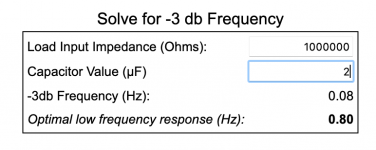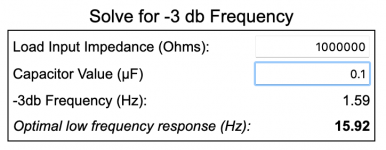Hi, I need to replace the output coupling capacitors in my tube-buffered DAC.
It uses a JJ 6386 LPG as buffer and then a pair of 2uF metallized propylene caps just before the outputs (together with a 1Mohm shunt resistor per channel).
I need to replace these caps.
I've been told that using higher capacitance here like 3.3 or 4.7uF will improve BASS extension : is that true? If so, what's the technical reason?
Thank you!
Gianluca
It uses a JJ 6386 LPG as buffer and then a pair of 2uF metallized propylene caps just before the outputs (together with a 1Mohm shunt resistor per channel).
I need to replace these caps.
I've been told that using higher capacitance here like 3.3 or 4.7uF will improve BASS extension : is that true? If so, what's the technical reason?
Thank you!
Gianluca
If you have a leak resistor of 1M in value and 2uF coupling capacitor, using the 3db point formula F=R*C then your responce goes down below 0.8HZ.
Way below any usable frequency!
0.1uF is a better choice. 4uF is far too large.
Way below any usable frequency!
0.1uF is a better choice. 4uF is far too large.
Attachments
Last edited:
The cap with the load impedance form a high-pass filter.
The cut-off freq. depends on your load impedance (amp input impedance or whatever your driving with the dac)
2uF with a 10K load gives a cut-off around 7.96 Hz
The cut-off freq. depends on your load impedance (amp input impedance or whatever your driving with the dac)
2uF with a 10K load gives a cut-off around 7.96 Hz
What is the reason to replace the caps ?Hi, I need to replace the output coupling capacitors in my tube-buffered DAC.
It uses a JJ 6386 LPG as buffer and then a pair of 2uF metallized propylene caps just before the outputs (together with a 1Mohm shunt resistor per channel).
I need to replace these caps.
I've been told that using higher capacitance here like 3.3 or 4.7uF will improve BASS extension : is that true? If so, what's the technical reason?
Thank you!
Gianluca
And 6386 is a variable-mü tube, that has inherent dist. A 5670 tube would be a better tube in a buffer.
If you have a leak resistor of 1M in value and 2uF coupling capacitor, using the 3db point formula F=R*C then your responce goes down below 0.8HZ.
Way below any usable frequency!
0.1uF is a better choice. 4uF is far too large.
... but 1M is the security load to avoid uncharge , and in the real world, What is THE INPUT LOAD of the next stage ??? 😉
I went to 8uF for 56k 😛
In a cathode follower duty even that kind of tube will sport low distortion can't prove it but can't hear a difference between a 6au6 and a 6ba6 both in triode mode in the same circuit 😀What is the reason to replace the caps ?
And 6386 is a variable-mü tube, that has inherent dist. A 5670 tube would be a better tube in a buffer.
Hi, I need to replace the output coupling capacitors in my tube-buffered DAC.
It uses a JJ 6386 LPG as buffer and then a pair of 2uF metallized propylene caps just before the outputs (together with a 1Mohm shunt resistor per channel).
I need to replace these caps.
I've been told that using higher capacitance here like 3.3 or 4.7uF will improve BASS extension : is that true? If so, what's the technical reason?
Thank you!
Gianluca
There is a huge price difference between a 6386 and 5670 - to no use.In a cathode follower duty even that kind of tube will sport low distortion can't prove it but can't hear a difference between a 6au6 and a 6ba6 both in triode mode in the same circuit 😀
Didnt know some one would pay so much for that kind of tube similar radio tubes are sold for peanuts in a ham fests
The 6386 tube is a remote cutoff tube used in limiters and compressors. No use in HIFI as it has no linear transfer if the operating point changes. Can be used with very small signals like in phono stages but not in as dac buffer.
I know it doesnt the same tube at all but...... 2K2M DHP Test – Bartola(R) Valves 2k2M is one of those tubes that can be awfull in paper.......
What is the reason to replace the caps ?
And 6386 is a variable-mü tube, that has inherent dist. A 5670 tube would be a better tube in a buffer.
The DAC (MHDT Stockholm V2) came with a NOS GE 5670 but the 6386 was in the compatibility list. Actually I had the chance to try-before-you-buy a JJ 6386 LPG (about 120 € for a brand-new tube currently in production) and the sonic difference was clear : the JJ 6386 sounds way better than the GE 5670 in this DAC.
A picture of the DAC board :

The cap with the load impedance form a high-pass filter.
The cut-off freq. depends on your load impedance (amp input impedance or whatever your driving with the dac)
2uF with a 10K load gives a cut-off around 7.96 Hz
The preamp input impedance is 20K.
I assume the 2uF is absolutely a value to stick to, am I right?
Thanks!
5670 Thoughts?
Originally the the 5670 or 2C51 was used in this DAC never the the tubes you have mentioned here.
Originally the the 5670 or 2C51 was used in this DAC never the the tubes you have mentioned here.
5670 Thoughts?
Originally the the 5670 or 2C51 was used in this DAC never the the tubes you have mentioned here.
This is the compatibility list issued by Jiun of MHDT :
Tube Issues
The JJ 6386 is recommended and actually, it sounds much better than the standard GE 5670. Mother, uncle...anyone can confirm that 😛
... but 1M is the security load to avoid uncharge , and in the real world, What is THE INPUT LOAD of the next stage ??? 😉
I went to 8uF for 56k 😛
So did you hear a difference in the bass response until you touched 8uF?
My preamp impedance is 20K.
Thank you!
2nd harmonics distortion sounds good "Mother, uncle...anyone can confirm that"
People here are trying to help and support you.
So a little appreciation is in place, don't you think?
People here are trying to help and support you.
So a little appreciation is in place, don't you think?
Last edited:
... but 1M is the security load to avoid uncharge , and in the real world, What is THE INPUT LOAD of the next stage ??? 😉
I went to 8uF for 56k 😛
2nd harmonics distortion sounds good "Mother, uncle...anyone can confirm that"
People here are trying to help and support you.
So a little appreciation is in place, don't you think?
Dear Lampie,
I thank anyone for the output coupling capacitor value matter.
The buffer tube is not on trial since I'm perfectly satisfied by the JJ 6386 that replaced the on-board GE 5670 after having the blessing of the designer.
Thanks,
Gianluca
- Home
- Amplifiers
- Tubes / Valves
- Output coupling capacitors : value


